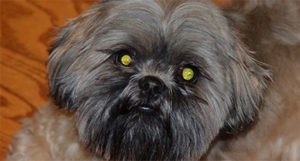ARTICLES
THE GHOSTLY GREEN GLOW: WHY DO ANIMAL'S EYES SHINE?
Published Thursday, December 15, 2016
 Ever wonder why your pooch’s eyes shine in pictures? Why do some animal’s eyes shine yellow, green, blue, or even red? Why can dogs and cats see better than humans in the dark? Can you eliminate the eye shine from your pictures?
Ever wonder why your pooch’s eyes shine in pictures? Why do some animal’s eyes shine yellow, green, blue, or even red? Why can dogs and cats see better than humans in the dark? Can you eliminate the eye shine from your pictures?
It all boils down to an iridescent structure in the back of the eye called the tapetum. This mirror-like structure lies directly behind the retina and reflects light back through the retina. This gives the retina and it’s visual cells (the photoreceptors) a second chance to register light that has entered the eye.
Most dogs have a partial tapetum, meaning that the reflective structure covers only about half of the back of the eye. Cats tend to have a larger surface area of their fundus (back of the eye) covered with the tapetum and therefore probably see slightly better than dogs at night time.
The tapetum will vary in color between species and among members of the same species. In dogs, for example, the majority of dogs will have a yellow to green tapetum. Some breeds, notably Schnauzers, will have a beautiful blue colored tapetum. Some breeds, like the Siberian Husky, will have no tapetum and will therefore have a red eye shine. As a rule of thumb, any animal with a blue iris will have a red eye shine. Yep, they will have “red-eye” in pictures just like people!
In addition to the tapetum, there are a few other reasons why animals have superior night vision. Their pupils are larger than human pupils and therefore allow more light to reach the retina. This also gives the camera flash a larger target to hit. A third reason for superior night vision in animals relates the visual cells called rods and cones. Rods are best suited for dim light and cones are best suited for perceiving color. Dogs and cats have a higher concentration of rods in the center of their retinas compared to people.
Don’t want the ghostly green glow in your pictures? Try taking the pictures in bright ambient light so that you don’t have to use the flash. An additional benefit of bright light is the fact that the pupil will be smaller creating a smaller target for the flash to hit. If the flash is a must, try taking the picture from an angle so that you are not pointing the flash directly at your pet’s eyes. Lastly, if you happen to have a camera that allows you to move the flash, try moving the flash away from the camera lens.
Happy Halloween!
 Located in the SAVS Facility
Located in the SAVS Facility
